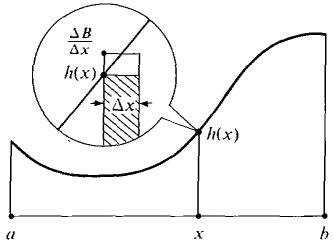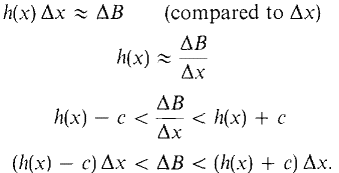| The ebook Elementary Calculus is based on material originally written by H.J. Keisler. For more information please read the copyright pages. |

|

Home  Applications of the Integral Applications of the Integral  Infinite Sum Theorem Infinite Sum Theorem  Infinite Sum Theorem - Proof Infinite Sum Theorem - Proof |
|






|
|
Infinite Sum Theorem - Proof
For example, 3 Δx + 5 Δx2 ≈ 3 Δx - Δx2 + Δx3 (compared to Δx) but 3 Δx + 5 Δx2 ≈ 2 Δx (compared to Δx). The Infinite Sum Theorem is used when we have a quantity B(u, w) depending on two variables u < w in [a, b], and the total value B(a, b) is the sum of infinitesimal pieces ΔB = B(x, x + Δx). he theorem gives a method of expressing B(a, b) as a definite integral.
Let B(u, w) be a real function of two variables that has the Addition Property in the interval [a, b] — i.e., B(u, w) = B(u, v) + B(v, w) for u < v < w in [a, b]. Suppose h(x) is a real function continuous on [a, b] and for any infinitesimal subinterval [x, x + Δx] of [a, b], ΔB ≈ h(x) Δx (compared to Δx). Then B(a, ft) is equal to the integral
Intuitively, the theorem says that if each infinitely small piece AB is infinitely close to h(x) Δx compared to Δx, then the sum B(a, b) of all these pieces is infinitely close to
Figure 6.1.2 PROOF
Adding up,
Now take standard parts,
or
Since this holds for all positive real c, it follows that
|
|
Home  Applications of the Integral Applications of the Integral  Infinite Sum Theorem Infinite Sum Theorem  Infinite Sum Theorem - Proof Infinite Sum Theorem - Proof |
|
Last Update: 2010-11-25



 (Figure 6.1.2). This is why we call it the Infinite Sum Theorem.
(Figure 6.1.2). This is why we call it the Infinite Sum Theorem.




